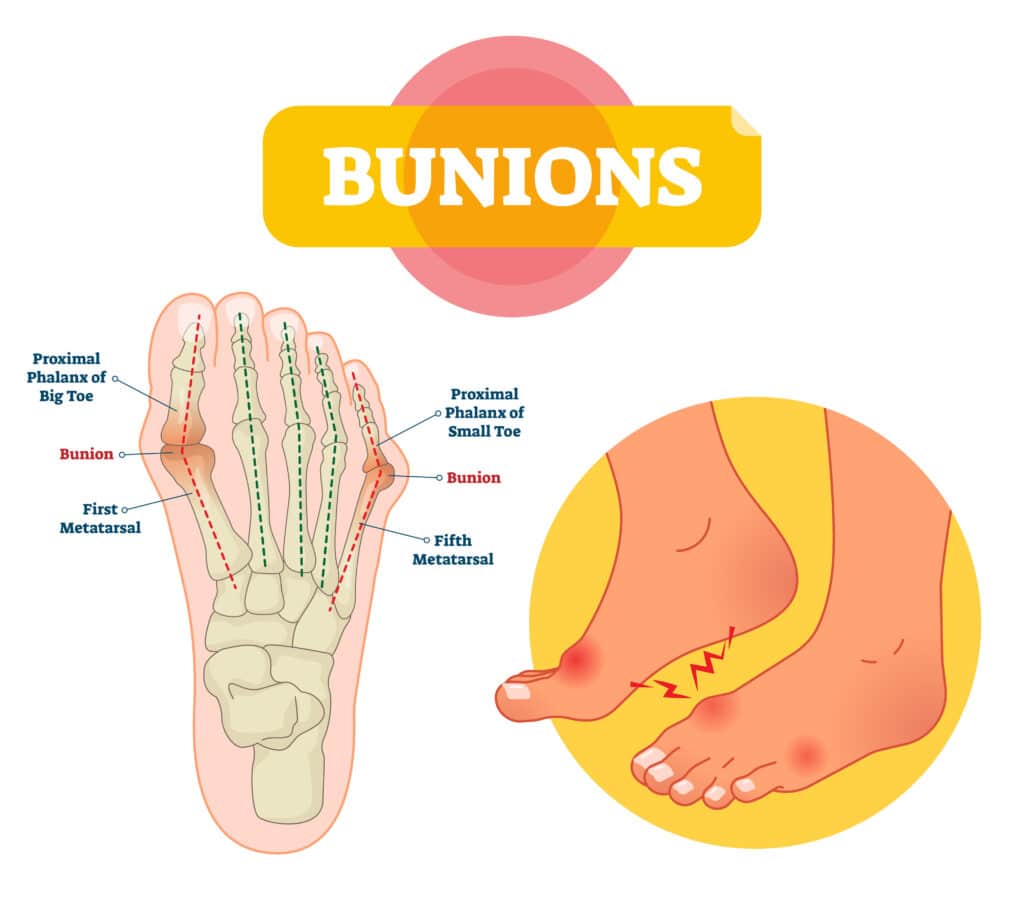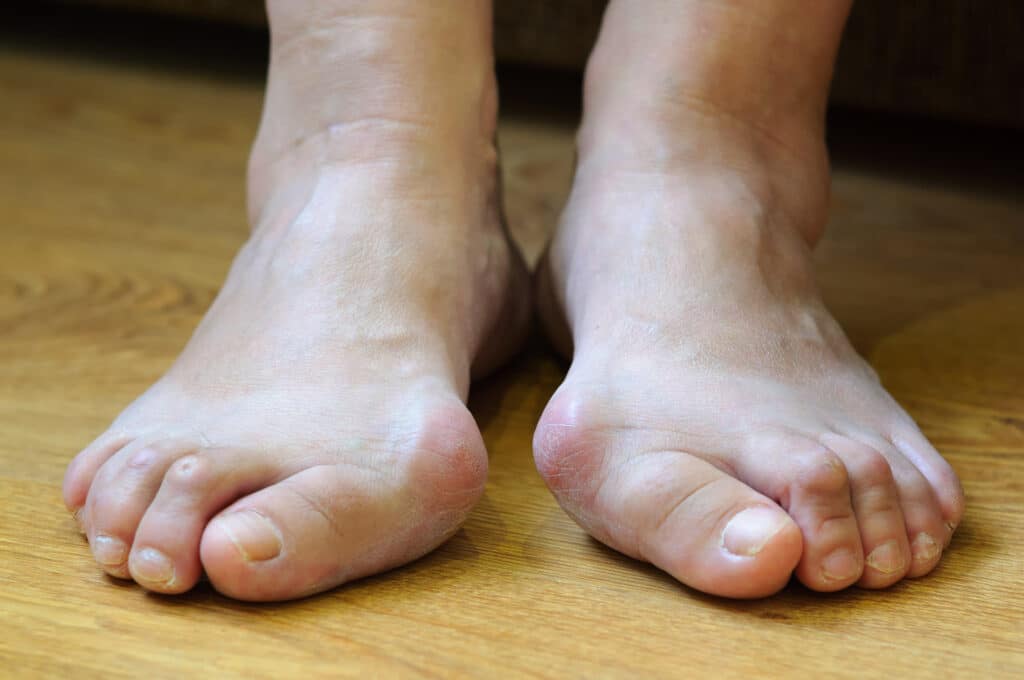What is the Best Treatment for Bunions?
Bunions are a prevalent problem, with a large amount of the population already suffering from or at risk of the issue. Bunion pain can be extremely bothersome and affect your quality of life, making understanding the condition and how to mitigate it essential in preserving your long-term foot health.
What Is a Bunion?
To put it simply, a bunion is a type of bony bump that can occur on the joint at the base of the big toe. It’s the result of musculoskeletal deformation, often propagated by years of pressure and misalignment on the foot. They can be painful, obstructive, and cumbersome to everyday life, often making things like wearing certain shoes uncomfortable or painful.
Bunions develop as a result of consistent adversity to the structure of the foot, wherein the bones are pressured out of natural alignment. Most commonly caused by things like slim-fitting shoes, pressures to the feet such as this cause the tip of the big to become pulled inward and force the joint at the base of the big toe, also known as the metatarsophalangeal (MTP) joint, to protrude. Over time, this can cause long-term adaptations and damage within the foot, where its structure is misaligned and the bone itself is inflicted. As a result, bunions can be very painful or even debilitating.

What Are the Symptoms of Bunions?
Bunions have two main components which characterize their presence, the ability to be seen and the ability to be felt.
Because they pertain to a widening and adaptation to the foot’s structure, it is usually straightforward to tell if your feet have bunions. While not the same severity for everyone, those with bunions will often notice a bump on the joint at the bottom of their big toe and sometimes hardened skin or a callus on the area. Bunions can also be distinguished through the orientation of the big toe itself, with it pointing inward, towards the direction of the smallest toe.
In tandem with its ability to be visually identified, those experiencing bunions will also likely have some degree of pain associated with the problem. This typically occurs on or around the bunion itself, as a result of direct pressure on the bone and frequent agitation.
Bunion pain can also extend beyond the foot, having the potential to affect areas like the knee and hip. What can be considered a secondary effect, problems in these other joints can develop as a result of the structural adaptation and misalignment of the foot caused by bunions. If bunion pain changes a person’s gait enough, the knees and hips are the first to take note, and they, in turn, adapt accordingly. This can cause extra stress on those joints and can result in the progression of pain in other areas in this way.
What Is Bunion Pain Like?
Bunion pain is experienced differently by every person. It can be minor to severe, and it may be steady or occasionally flare up. The top of the foot can become painful, inflamed, and swollen, with the ball of the foot holding the potential to be inflicted as well.
You may experience bunion throbbing at night in your big toe, or pain that extends into the ball of your foot during the day. Your bent big toe may also put pressure on your other toes, causing further damage such as hammertoes or corns.
Pain can be increased with certain activities or motions, like walking downstairs or even standing for long periods. Shoes that have a narrow toe box can also cause bunion pain because they compress the big toe joint and rotate your foot inward.

What Are the Treatment Options for Bunions?
There are many ways those suffering from bunions seek to find relief, most commonly in the form of mitigatory measures.
One of the most straightforward approaches, many people apply ice to reduce bunion pain caused by inflammation or extended pressure. This can help relieve soreness and swelling, however is more of a reactive approach taken by those with less severe cases.
Over-the-counter supports are also popular and can provide relief for some people by numbing existing pain. Other people go a step further and use prescription orthotic devices to regulate their foot’s motion and resulting pain.
When it comes down to it, however, bunions won’t go away without direct treatment. While devices like orthotics and splints can help improve the positioning of the foot and assist foot functioning, they cannot stop or reverse the development of a bunion. The only way to really get rid of a bunion is through surgery. While not suggested for all individuals, there are some cases in which we will recommend Lapiplasty for their patients. This entails surgically reducing the bump that causes pain on the side of the foot, repositioning the big toe into better alignment, and fixing the tendons or ligaments around the affected joint.
Left untreated for long periods, bunions can continue to expand in size and twist the other toes out of alignment, giving the side of the foot a swollen or bent appearance. Ultimately, the less attention that is paid to the problem, the worse the consequences will likely be.
For this reason, it’s advised to employ non-surgical treatments as soon as you begin to develop a bunion. Nonsurgical treatments can help relieve discomfort, improve comfort, and decrease the development of a bunion. With their ability to reduce existing stresses and manage the development of the issue, they’re key to maintaining overall foot health long term and avoiding the need for surgery down the road.
Bunions are a serious issue for those who develop them and can cause debilitating pain during certain activities. While most bunion treatments center on mitigating the existing symptoms, surgery is necessary in some cases to really treat the foot disorder. To avoid developing a bunion or worsening its condition, it’s important to address your pain early on and to likewise prioritize the health of your feet.
The Community Foot Clinic of McPherson is here for you, so if you need help, be sure to request an appointment online or give us a call at (620) 241-3313.
McPherson Office
316 W. 4th Street
McPherson, KS 67460
P: (620) 241-3313
F: (620) 241-6967
© Community Foot Clinic of McPherson. All Rights Reserved.
Privacy Policy | Terms & Conditions
Web Design by CP Solutions
Marketed by VMD Services
